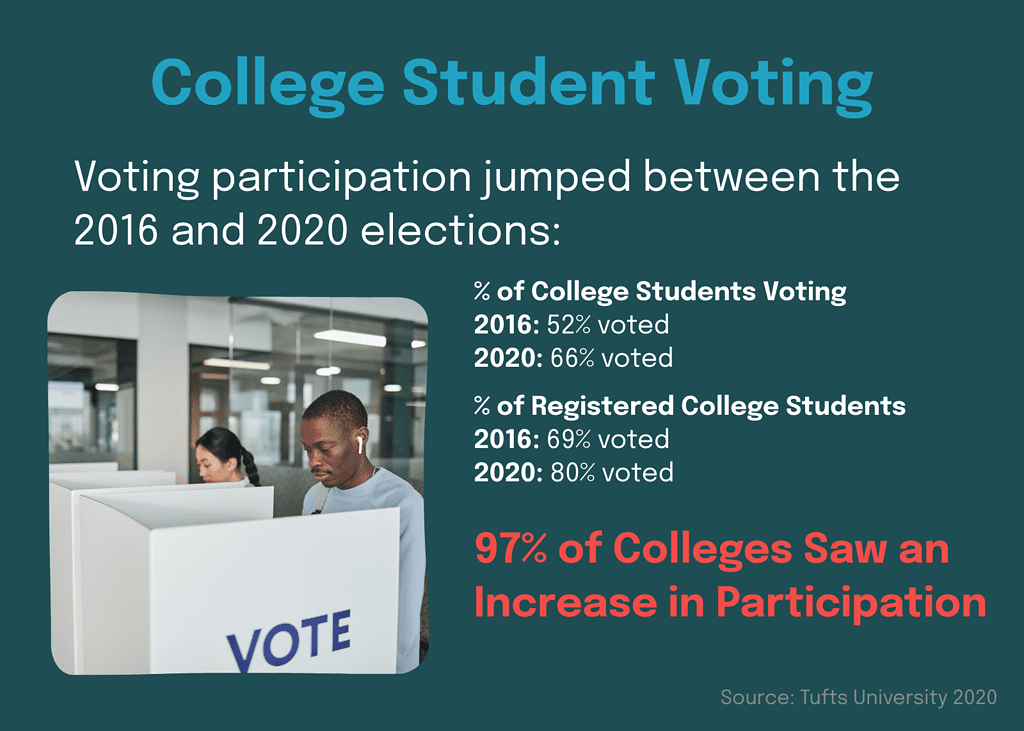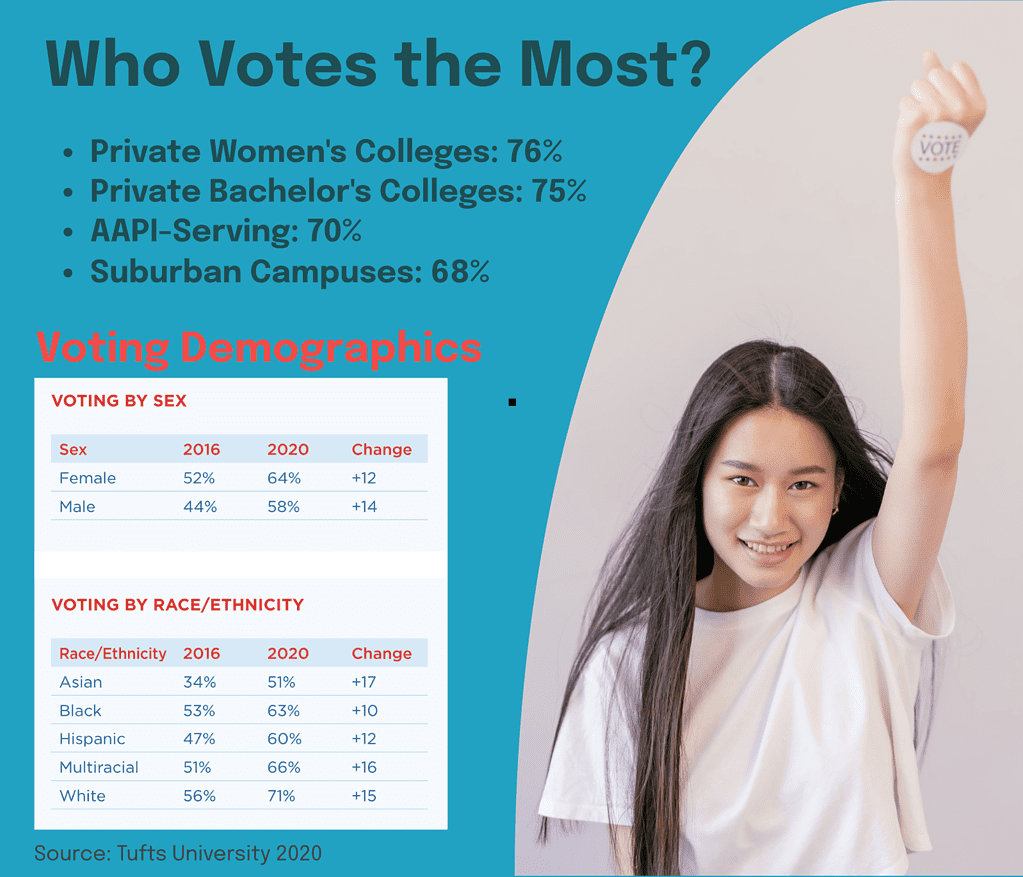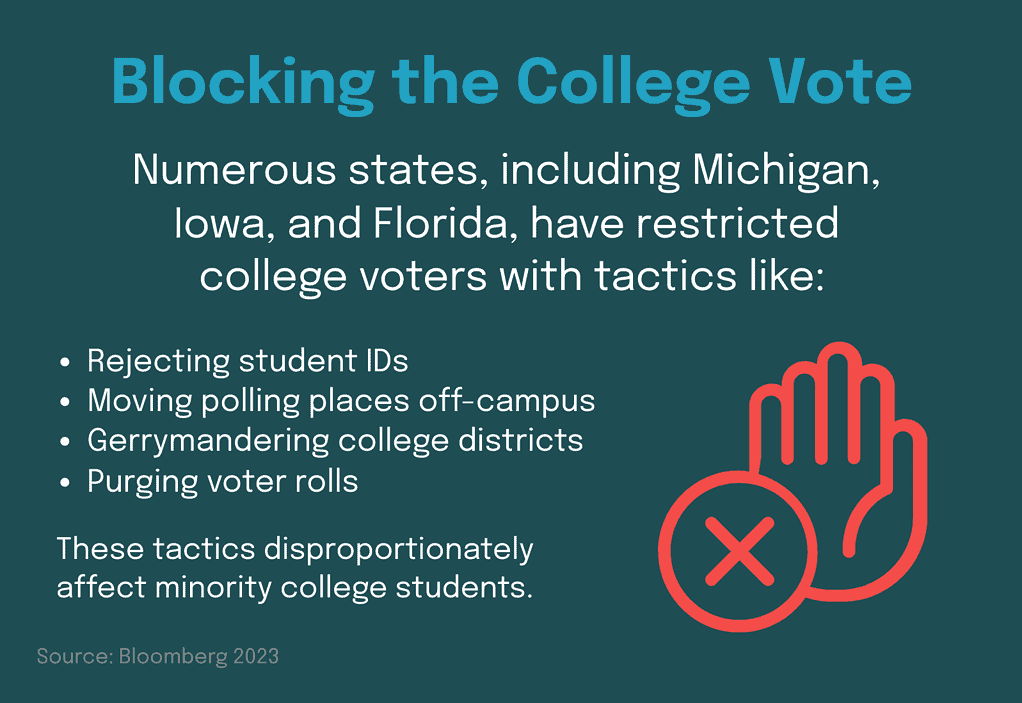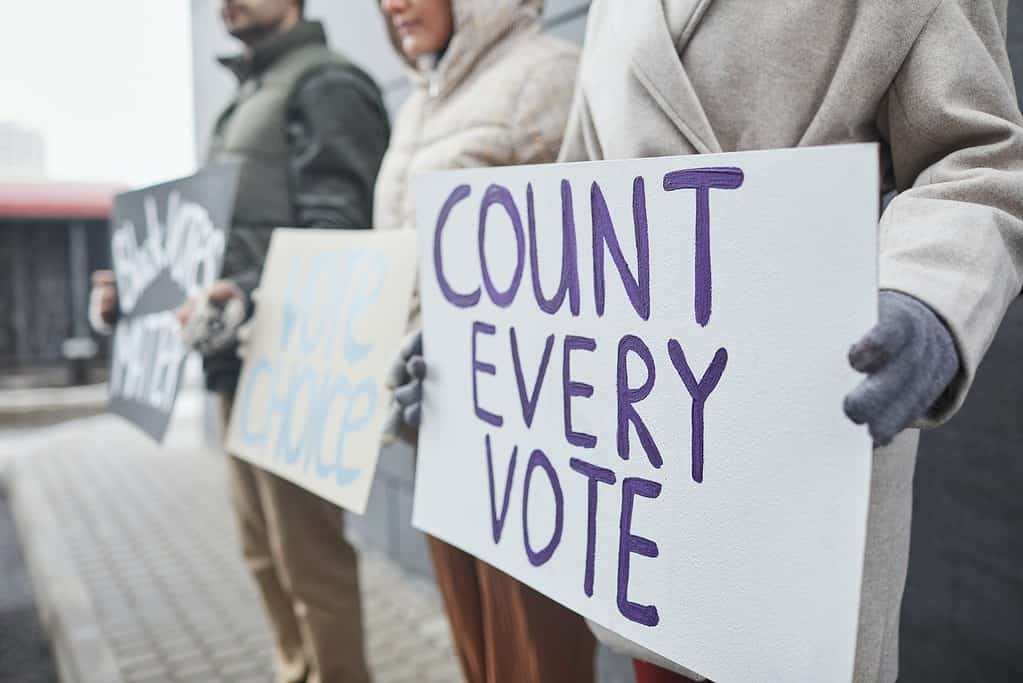Voting is an important right that forms the foundation of American democracy. However, despite earning the right to vote at the age of 18 over 50 years ago, students don’t turn out to vote in large numbers. Some of this is due to a lack of education, some of it is apathy, and some of it’s the result of interest. Recent political events show how democracy changes on slim turnout numbers, indicating that a large number of young Americans don’t understand the election process or the impact of not voting, much less learn from their lack of effort.
The amount of students engaging in their civic duty to vote has been steadily increasing, but it’s important to maintain this momentum and keep people returning to the polls as they age. Educating college students about the importance of voting results in people who vote for the rest of their life in order to shape the political narrative to one that favors everyone no matter where they live. That’s why College Consensus has compiled this useful guide to election information for students.

Stats About Voting
2020 saw a record number of college students casting their votes for the presidential election. 66% of all college students voted, an increase from the 52% turnout rate in the 2016 race. Just about every college campus in the US saw an increase in voting participation among its students. This indicates that Gen Z wanted to make a difference in their world, and decided to make their voices heard through the ballot box.
Making a difference through voting
For decades, elections at the local and national level were won by slim margins due to the lack of interest among student and non-student voters. Social media has increased voter awareness, especially among college students. It’s also much easier to learn more about a candidate’s platform, their background, and their intention to make their communities a better place to live. Student voters are learning how their vote directly affects the world around them and their ability to become civically engaged.
Voting by generation
Gen Z is arguably the most informed voting bloc due to their familiarity with social media and how to find information online. They use social media and trusted information outlets to find the information they need to help them make a decision about a candidate or initiative. Generation Z is using their strength in numbers and education to form their political ideology, identify candidates to align themselves with, learn how to register to vote, and stick to a voting plan.
This drive is unlike older generations that tended to be less engaged or vote along a political party line. Gen Z are less moved by political parties and more by candidates’ actual platforms. Gen Z voters cast their ballots not for a political campaign, but for ideas.
How to reach voters
Reaching voters begins with programs that seek to reach students and their communities back home. Nonpartisan initiatives and programs that include community outreach, printed guides, websites, and volunteering have the most success when it comes to reaching voters. Students can engage in outreach programs on their campus and talk to fellow students about the importance of voting. They can also hold rallies, meetings, presentations, and just about any method of disseminating information to their fellow students, friends, and families to encourage voting registration and participation.
Getting Started with Voting
The following resources help you learn how to get yourself registered to vote and the various options you have to make sure your vote is received and counted, including how elections work, electoral participation, and more on the national and local level.
Absentee Ballot Rules
Absentee voting, also known as voting by mail, consists of mailing in your ballot before Election Day. The laws for absentee ballots differ from state to state with some states requiring a valid excuse for not being able to vote in person, while others allow anyone to vote by mail.
Complete Guide to College Voting
Students who attend schools that are far from where they are registered to vote can still send in a ballot. They can also register to vote even if they’re nowhere near their home address. A student can decide where they wish to be registered as long as it’s done in a timely manner before Election Day.
How to Register to Vote
There are a multitude of ways in which a student can register to vote. One option is to start at Vote.gov, register at a local department of motor vehicles or driver’s license services, find an armed forces recruitment office, the local polling place, or contact the local public assistance office.
How to Vote:
Now that you’ve registered, you can vote by mail in ballots or in person on election day. Here’s a look at the steps to take before and during the voting process, including open primaries vs closed primaries, congress, and general election.
7 Simple Steps
You’re asked to pick a party affiliation when you register to vote, but you can vote for anyone you wish, regardless of their political affiliation. Researching the candidates and their platform helps you make up your mind as to who you’re voting for. Once a decision is made, cast your ballot via your preferred method.
Make a Voting Plan
It’s a good idea to make a plan before Election Day draws near, especially if this is the first time you’re voting. The act of voting is quick and easy, but it never hurts to be prepared before voting by mail or in person after deciding upon a candidate.
Out of State College Student Voting Guide
Students who are attending a school in other states have the option to register to vote in local elections where they’re residing as they attend school. They can also choose to maintain their registration at their permanent address (IE family home) and vote by absentee ballot.
Voter Q&A (UNC)
The Voter Q&A answers many common questions students have about voting for the first time. What’s a caucus? What are interest groups? How do these idiots get elected to government? The in-depth answers help the reader understand the steps they need to take to become an eligible voter.
Voter’s Guide to Federal Elections
This guide is published in 11 languages to help voters understand and navigate federal elections, including primary elections, vice president and president, and more. It also contains information about early voting, understanding the electoral college, and the voting process for citizens living abroad and members of the military who are stationed overseas.
You Can Vote
The state of North Carolina has published a guide that shows students and residents the steps they need to take in order to vote in federal and state elections and get your first “I Voted” sticker.
Your 2022 Guide to Voting in College: Tips for Students and First-Time Voters
Don’t let the 2022 date on this guide keep you from reading it. The information it contains for students and first-time voters is valid and helps students understand the voting process from start to end, from George Washington to local representatives.
Research on Voting and College Students
The following articles cover the latest and ongoing issues that affect voters’ ability to get their voices heard through their votes.
College Student Registration and Voting in the Time of COVID-19
The COVID-19 pandemic has faded, but it’s still a very real issue that can dissuade students from voting for fear of exposure. This article discusses how students can register to vote and take advantage of different methods to submit their ballot without coming into contact with large groups of people.
Fighting a New Wave of Voter Suppression: Securing College Students’ Right to Vote
Voter suppression is an ongoing issue that affects just about every demographic, including students. This article discusses the history of voter suppression and the modern versions that affect students’ right to vote.
Getting Registered and Getting to the Polls
An in-depth study into the effectiveness of on-campus voter registration activities that includes registering students to vote and if students actually vote afterwards. The study also seeks to determine if voter turnout rates were higher as a result of the efforts made.
How, and For Whom, Does Higher Education Increase Voting?
This article explores the concept between higher education and an increased interest in participating in politics through voting. It finds that the link may not be as strong as once thought, and that other socioeconomic factors also play a role in the desire to vote.
Learning to Vote: Informing Political Participation among College Students
This research paper looks into the reasons why young people are the least likely of all demographics to vote or engage themselves in civic or political activities leading up to Election Day. The study looks at different influences that may increase the desire of young people to become politically active.
Student Voting Is Not Where It Should Be
Over 50 years ago, the legal voting age was lowered from 21 to 18. This article explores the fact that voter turnout among young voters has not increased despite the lowered threshold for the legal age to vote.
Turnout for What? Do Colleges Prepare Informed Voters?
A look at how college administrations fail or help their student populations learn about the importance of registering to vote and casting a ballot.
Why College Student Voting Matters
This study highlights why it’s important for college administrations to take action with regards to showing students how to become civically engaged and getting registered to vote.
Voter Turnout Among College Students: New Data and a Rethinking of Traditional Theories
This article takes a look at traditional theories regarding low student voter turnout and re-examines the logic behind them.
Voting at UMaine: An Empirical Study of Student Turnout Trends and Motivations
The paper takes a look at the downward trend of student voting numbers and the reasons why students are less likely to vote. It examines the barriers students face when attempting to register to vote and the obstacles they face when casting a ballot.

Voting by State
Ballotpedia
Ballotpedia has created a list of voter guides for each state that list current ballot measures, the dates they come up for a vote, and provides links to official websites where source information is found.
Best Colleges
Best Colleges has put together a resource page to help students overcome voting challenges in their home state or the state they’re attending college in.
Campus Vote Project
Campus Vote Project has created a voting guide for each state to help students learn how to register to vote, the places they can go to register, and the official election websites for their state.
Fair Elections Center
The Fair Elections Center provides state specific resources to help students find places to register to vote, ID requirements for voting, election dates, and options for student voters to vote at their home address or use their campus address.
Vote 411
Vote 411 gives voters the basic information they need to register to vote, how to find their polling place, check their voter registration status, and learn more about local and national candidates.
Voting by Population
Certain demographics, or populations, need to vote in their own interest in order to protect their rights and needs. Getting these populations to vote helps them improve their quality of life and desired political outcomes.
LGBTQ
Even with more acceptance in the 21st century, LGBTQ+ Americans face significant obstacles. Engagement in politics is key to their safety and well-being.
The 2020 LGBT Vote
Covers the statistics and voting preferences of the LGBT voting block during the 2020 elections, and how to improve voter turnout in future elections.
2022 General Election LGBTQ Voters’ Guide
This guide is focused on Florida elections and how the candidates may vote in ways that affect the rights of the Florida LGBTQ population.
Coming out to Vote: The Construction of a Lesbian and Gay Electoral Constituency in the United States
The article discusses how the LGBTQ voting bloc was formed and their various political affiliations were formed.
Exploring voting habits and attitudes of LGBTQ+ college students in the United States
A thesis that explores the reasons why the student LGBTQ+ voting bloc votes in higher numbers than their straight counterparts.
GLAAD Vote
Helps LGBTQ+ individuals overcome common difficulties they face when registering to vote and casting a ballot.
Guidelines for LGBTQ Individuals Using a Preferred Name
Guidelines for transgender, non-binary, gender-non-conforming individuals who use a preferred name that doesn’t match their legal name.
Human Rights Campaign Voting Center
The HRC seeks to engage over 62 million Equality voters to turn out and vote for LGBTQ+ friendly candidates.
League of Women Voters
The League of Women Voters is a nonpartisan organization that works to empower women voters through advocacy and litigation. Students can get involved by becoming a member of their local chapter.
Political Participation of LGBT Americans
An insight into the demographics and reasons why the LGBT population in America is more politically engaged than the heterosexual population.
Queer the Vote
Encouraging the LGBTQ community to register to vote and cast a ballot for candidates that seek to help marginalized voters.
Hispanic/Latinx
The Latino population in the US has long faced difficulties with voting due to language barriers and other issues. The following information shows how Latino students can empower themselves through voting.
America’s Future: The Power of the Latino Vote
A look at the increasing role Latinos are playing in local and national elections, and how more Latinos are registering to vote than ever before.
Key Facts About Hispanic Eligible Voters
The hard data behind the increasing numbers of eligible Hispanic voters and where they’re having the largest impact.
Latino Community Foundation
The Latino Community Foundation seeks to engage California Latino residents in their civic duties, helps local organizations get the word out to vote, and building a better future for all Latinos.
The Latino Vote
Insight into the growing influence Latinos are exerting on presidential elections in the U.S.
Latino Voters at High Risk for Misinformation in Midterm Elections
This article explores the attempts that are being made to disenfranchise Latino voters through misinformation campaigns.
Movimiento Hispano
Encourages Latinos to be counted during census years as well as the importance of registering to vote. It shows how Latinos can use the internet to become civically engaged.
New midterm data shows Latinos helped Dems win key races
A study shows that the Democrats didn’t lose as many Latino voters as they thought.
The Power and Diversity of the Latino Voting Bloc
An interview with a Northwestern University faculty member about the voting power and strength of a diverse population that’s collected together under a single ethnic identifier.
Unidos US
A Latino civil rights organization that seeks to empower Latinos by showing them how to register to vote and investigate candidates and their platforms.
Voto Latino
An activist organization that seeks to engage Latino voters by educating them on the effect their vote has on their communities.
Black and African American
Black and African Americans have a long history of voter suppression that continues to this day. The following guides show how the Black community can continue to exercise their hard-earned right to vote.
Black the Vote
Black the Vote seeks to teach the history of voter suppression to black college students, get them to use their hard-won right to vote, and show them how to become effective voters, poll workers, and poll monitors.
The Black Collective
Focuses on informing Black voters of local issues in Miami-Dad County, Florida, as well as providing information regarding national elections.
Black to the Future
Black to the Future highlights the importance of voting by the Black community in the states of California, Georgia, Louisiana, North Carolina, and Wisconsin.
Black Women for Wellness Action Project
A coalition of Black women who seek to improve the turnout numbers for Black female women who have been consistently underrepresented in American politics
Black Women Vote
Black Women Vote encourages Black women to empower themselves through their vote. The organization helps with registration, getting absentee ballots, and showing how to make a voting plan.
Black Voters Matter
Black Voters Matter is an activist organization that encourages Black voters to exercise their right to vote and become active in their communities to get out the word to vote.
The HBCU Legacy Initiative
The HBCU Legacy Initiative discovered that the number of students who attend HBCU schools and voting was decreasing. The initiative seeks to uncover the issues that prevent young Black students from voting and providing voter education.
NAACP Power Your Vote
Shows Black voters how they can make a difference in their lives by voting for candidates that have the best interests of their constituencies at the forefront.
Southern Poverty Law Center
The Southern Poverty Law Center is an organization that uses legal action and initiatives to fight against efforts to prevent people of color from voting in southern states.
Voting While Black
Voting While Black is an outreach program that seeks to teach Black people and their allies to learn more about political candidates whose values align with the Black community.
AAPI
The Asian American and Pacific Islander groups are experiencing a surge in growth as a voting bloc in the US. The following information helps AAPIs learn how to vote and protect their interests.
AAPI Data
AAPI Data breaks down the statistics and demographics of Asian voters, their perspective on civic engagement and voting, and the hurdles they face when trying to register to vote and casting their ballot.
AAPI Equity Alliance
The AAPI Equity Alliance seeks to advocate for the AAPI communities in Los Angeles county. It puts out a voter guide for every major election cycle to educate AAPIs as to the current issues and candidates on the ballot.
AAPIs for Civic Empowerment
Also known as AAPI FORCE-EF, the collective seeks to encourage AAPI’s through the use of their vote to make positive changes for the AAPI community as a whole.
The AAPI Voter Bloc
This guide highlights the growing numbers of AAPIs in the U.S. and how they create significant voting blocs in various states.
AAPI Voter Guide
The AAPI voter guide covers candidates and ballot initiatives in the greater Orlando, FL, region. It provides information on how AAPIs can register to vote and information on local candidates.
APIA Vote
APIA Vote seeks to bring together the Asian and Pacific Islander communities into a cohesive voting bloc. The organization provides information about voter registration and the impact that voting has on local and national politics.
Asian Americans Advancing Justice
Asian Americans Advancing Justice is an organization that seeks to overcome voting restrictions and empower the AAPI community by educating them about their right to vote.
Guide: How to Talk About Voting in AAPI Communities
This guide shows how people in the AAPI communities can talk about voting with one another and encourage friends and family members to register and vote on Election Day.
North Carolina Asian Americans Together
A voting guide for Asian American residents of North Carolina. The guide covers how to register to vote, important dates that relate to elections, and how and where to vote.
Voter Guide for Asian American and Pacific Islander Students
Best Colleges provides a guide to voting for AAPI students and explains how they can become civically engaged in the US. It also highlights the issues that AAPI students face when registering to vote and casting their ballot.

Activism on Campus Resources
Politics affects everyday life in ways that are obvious and subtle. Encouraging students to become engaged in civics shows them how their vote can shape their future and everyone else’s.
ALL IN
ALL IN is a nonpartisan and national initiative that seeks to engage students in American democracy through outreach activities. Students learn about how their vote makes a difference in local and national politics.
Ask Every Student
A national initiative that gets the figureheads on campus asking every enrolled student to vote in local and national elections with a goal of achieving full voter registration in each student body.
Campus Voter Project
Provides a voting guide for every state, and is intended for students who are attending campus in their home state or out-of-state. Students can use the guides to determine their voting location.
Fair Elections Center
Fair Elections Center is a nonpartisan voting rights and election reform organization that uses litigation to stop efforts that are intended to block people from voting.
Rock the Vote
Rock the Vote uses popular figures in music and sports to encourage students to vote. The organization creates voting awareness campaigns and teaches students how to register and vote.
Student Learn Students Vote
The Students Learn Students Vote (SLSV) coalition is the largest nonpartisan network in the US. It seeks to increase turnout among student voters through education and leadership.
StudentVote.org
StudentVote.org teaches students how to mobilize the youth vote on college campuses regardless of a student’s political affiliation.
When We All Vote
When We All Vote is a nonpartisan effort to encourage people to register and vote, and how to overcome voter suppression.
Voter Friendly Campus
The Voter Friendly Campus initiative helps colleges and universities create actionable voting plans to encourage students to register to vote and cast a ballot on Election Day.
You Can Vote
You Can Vote is an organization that teaches volunteers how to engage people through voter education, showing them how to register, and impart the power behind an individual’s vote.

FAQs
Do College Students Have to Go Home to Vote?
No, college students don’t have to go home to vote. Provided they decide to maintain their primary address at their parent’s house or their place of permanent resident, they can vote via an absentee ballot.
For college students, the right to vote is an important part of their civic duty. However, many may find themselves in a situation where they have to choose between voting and returning home. Fortunately, there are options available that allow college students to exercise their right to vote without having to go home. With absentee ballots, college students can maintain their primary address at either their parent’s house or their place of permanent residence and cast their vote via mail or online. This ensures that even if they are away from home, they still have the opportunity to make their voice heard in elections.
Can I Register to Vote Where I Go to School?
Yes, as a general rule, you can register to vote where you’re currently attending school. The rules for registering differ from state to state, but your dorm room or apartment address gives you legal resident status for the region or state where you happen to be attending school.
The ability to vote is a fundamental right for all citizens in the United States. Fortunately, college students can take advantage of this right even when they’re away from home. With a few simple steps, you can register to vote where you currently attend school, no matter which state you’re in. While the exact rules vary from state to state, your dorm room or apartment address gives you the legal standing to register and participate in local elections.
Can I Vote By Mail from College?
It depends on the voting rules of the state of your primary residence. Most of the time, states allow college students to mail in their vote from a different state, but it’s not a blanket rule. Make sure to check the voting rules of your state before you leave for college and request a mail-in ballot if given the option.
Voting is one of the most important rights of citizens, and it’s especially important for college students who are away from home. However, not all states allow college students to mail in their vote from a different state. Numerous states – especially conservative-led states – have been cracking down on vote by mail in recent election years, claiming mail voting contributes to voter fraud.
In 2017, a study was conducted in Washington state that revealed more than a quarter of the mail ballots sent out were either not returned or spoiled. That same year, a Colorado third-party study found that roughly 1 in 6 ballots were cast by mail with no signature.
Some states offer citizens the option to choose between voting by mail or going to their neighborhood polling site on Election Day; however, only Oregon lawmakers have succeeded in getting their voters to predominantly vote through paper ballots.
It’s important for students to check their state’s voting rules before moving away for college, so that they can make sure their votes will count.
Do I Need an ID to Vote?
Voter ID laws vary from state to state with some states requiring them to vote, while others do not. If you’re not sure about your state’s rules, you can check online, call your township, or bring your ID with when you go to vote.
Across the United States, voter ID laws have become increasingly popular in conservative states. These laws often require citizens to present a form of identification before they can cast their ballot, and have been implemented as a way to prevent voter fraud. Despite criticism from civil rights advocates for making it harder for certain individuals to vote, these laws have been gaining support from conservative lawmakers in recent election cycles.
However, there is no evidence that requiring an ID actually prevents voter fraud. The debate around voter identification has been ongoing for decades. While some argue that requiring an ID at the polls is necessary to prevent voter fraud, there is no evidence to support this claim. In fact, research suggests that the only people who are negatively impacted by voter ID laws are those from minority communities who may not have access to valid forms of identification.
This is often also true of young people, including college students. Many out-of-state college students may not have a valid ID from the state where they are studying, even though they are qualified to vote there.
What is the current status of these changes to voter identification requirements?As of 2016, twelve states require photo ID for in-person voting. The remaining states and D.C. allow voters to present a variety of different forms of identification which are not restricted to DMV-issued identification. Ultimately, implementing voter ID laws does not appear to be an effective way of preventing fraud and can instead lead to disenfranchisement.
If you’re unsure of your state’s rules and regulations, there are several ways you can check online, call your local township or bring yourself a valid form of ID when you go to vote. No matter which state you live in, it’s important that you take the time to make sure you have all the information necessary before heading out to the polls.
What Can I Do if My Right to Vote is Violated?
Voting is a cornerstone of our democracy and it is essential that every citizen have the right to have their voices heard. Unfortunately, there are times when this right may be violated. If you feel your right to vote has been violated, it is important that you contact your local state attorney’s office and the Civil Rights Division of the Department of Justice. Both agencies take these allegations seriously and will work to ensure that any violations are addressed swiftly and effectively.
In what ways might your right to vote be violated? It can be through voter suppression, gerrymandering, voter intimidation, and other tactics which prevent people from exercising their right to vote freely. While an issue like gerrymandering affects people on a large scale, voter suppression and intimidation can be very specific and localized. Some forms of voter intimidation include:
- Threats of violence against specific voting places (like in minority neighborhoods)
- Aggressively questioning voters about their qualifications
- Brandishing firearms near a polling place
- Following voters around in a harassing manner
- Impersonating law enforcement or other authorities to confront voters
- Writing down license plates or taking photographs in parking lots
Voter intimidation and suppression can have a huge impact on the outcome of elections and ultimately the direction of the country. It is important for everyone to be aware of these violations and take steps to ensure that their right to vote is not violated in any way.
Related:
Ultimate Campus Guide for LGBTQ Students
